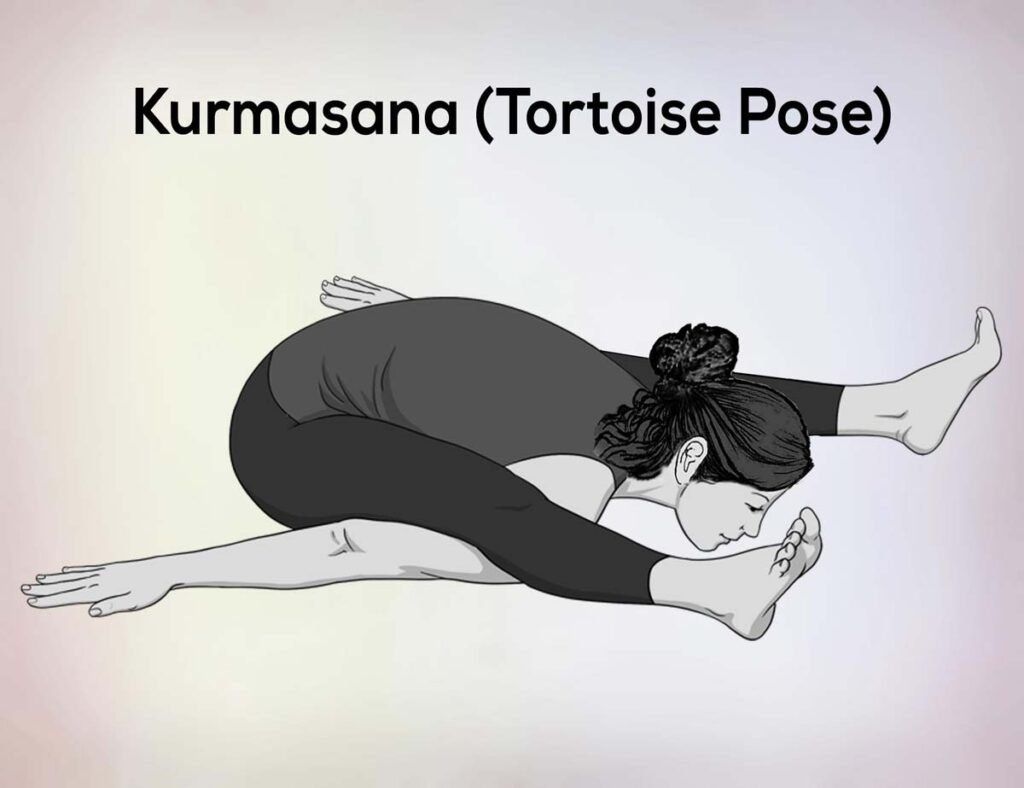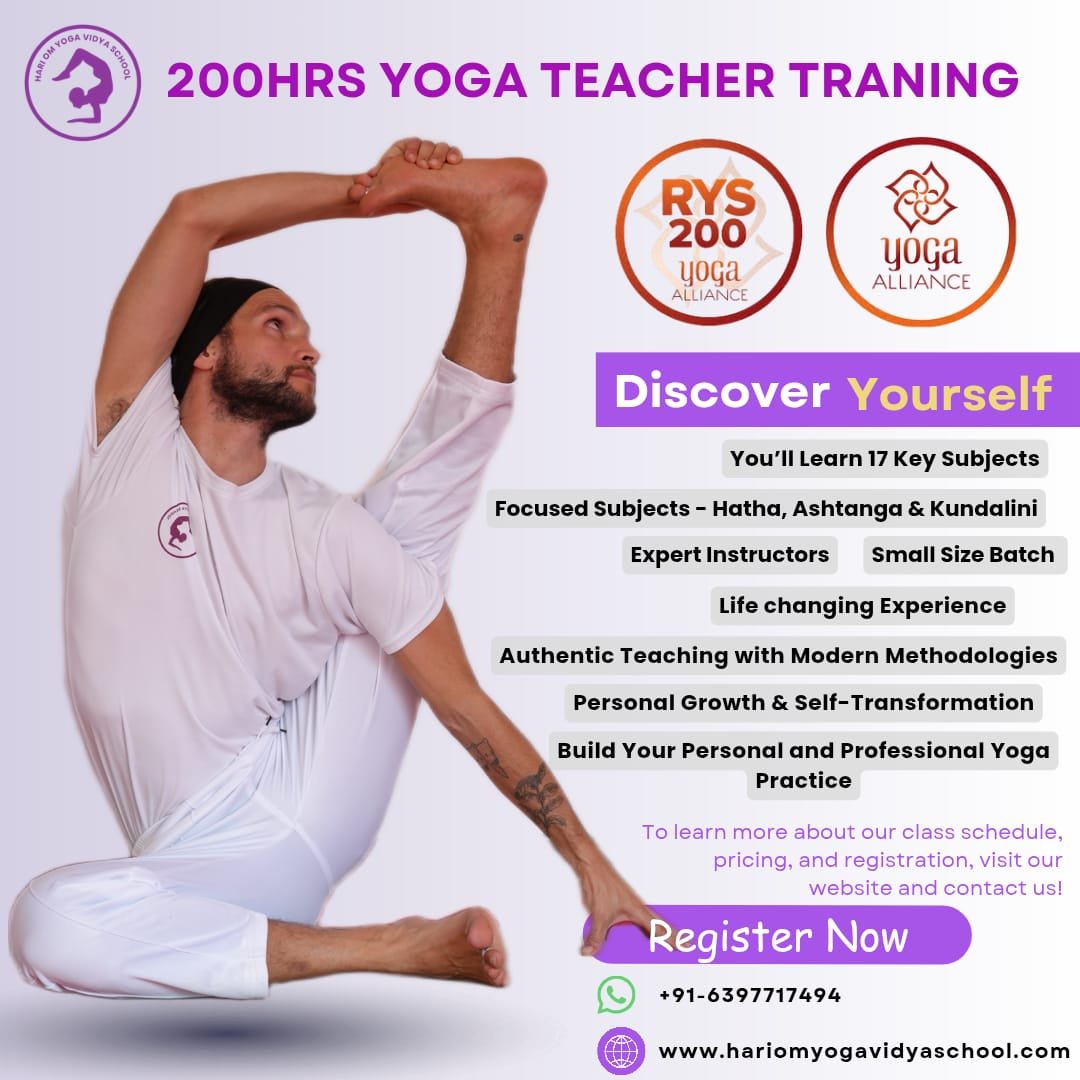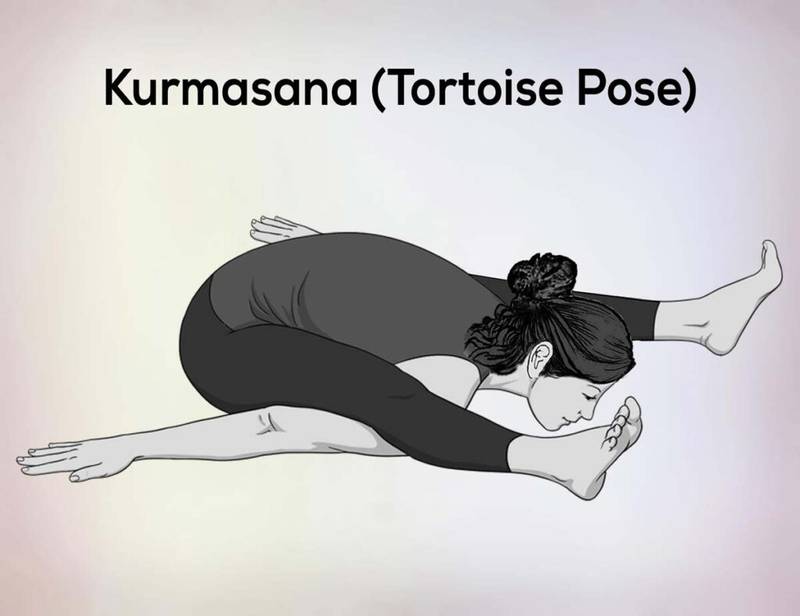Kurmasana – Tortoise Pose
What is Kurmasana?
Kurmasana is a seated forward bending pose, which has got its name from the tortoise or the turtle. After you have reached the final position, your body looks like a tortoise. The asana was first mentioned in a few 7th century texts. The pose or asana is dedicated to Lord Vishnu’s incarnation.
It is an advanced bent position in the Ashtanga Yoga series. The practice of this asana leads to mental, physical, and emotional well-being. So, you can use this asana for overall fitness.

The name of this asana has been derived from Sanskrit verses.
- ‘Kurma’ means ‘tortoise’
- ‘Asana’ means ‘pose’
In this pose the yoga student or practitioner stretches both legs forward, hip-width apart and holds the hands at the back, while bending forward. You may know that the tortoise suddenly withdraws itself within its hell, when threatened. In the same manner, this pose allows you to draw your senses inwards, so that you can detach yourself from the worldly attachments.
Read More: Why Is Kundalini Yoga Dangerous? The Truth About Its Risks and Rewards
How To Do The Kurmasana?
You can do Kurmasana or this pose quite easily, with some guidance.
- Begin from the staff pose or Dandasana. Your legs should be outstretched, and the hands should be placed beside the hips. You have to press both the thighs firmly to the ground.
- You have to spread both the legs, in such a way, so that the space between them is more than the distance between your shoulders.
- Bent your knees a little and gently fold forward, and take the arms forward between the legs.
- You have to bring the chin in contact with the floor, while sliding both your hands underneath the knees. The elbows must be under the knee caps.
- Now, you can expand your chest and increase the breath of the collarbones. You have to press your shoulders and upper arms with your thighs.
- Your inner heels should be pushing down, in the forward direction. The legs should be stretched and straightened.
- Maintain the pose for 1 minute or so.
- Gradually, side back the arms to their original position and relax the spine.
- You can also shake both the legs to relax them a bit. Loosen the shoulders as well.
Modifications and Variations
You can try out the Kurmasana pose in various other forms, according to the ease. Apart from that, you can also try to use certain props.
- All the beginners who are unable to touch the ground with the chin, can keep the head floating at a comfortable distance from the floor.
- If you have very rigid shoulders, you may have a problem, sliding your hands underneath the knees. In that case, you can do the same pose, by holding a strap, which is wrapped around the back, with your hands holding them in front.
- You should have very flexible hamstring, to deepen the forward bend. You can practice some of the preparatory poses, to loosen the hamstrings and thigh muscles. Dhanurasana is a great preparatory pose for you.
You can try out a variety if variations:
Supta Kurmasana is one of them. In this, you have to follow the following steps:
- Begin the asana in the same way, as you would begin the Kurmasana. Try to sit in a manner, so that the forehead touches the floor.
- No, slowly take the legs above the head and place them across the neck.
- Take the arms one by one to the back, and clasp them in an interlock behind the back.
You can also try Ardha Kurmasana.
You have to sit in a typical Vajrasana and stretch your hands straight forward, while bending forward.
Then, you can also practice the Uttana Kurmasana.
This is quite similar to Garbha Pindasana.
You should breathe normally. Keep your head in neutral position and gaze in the forward direction.
Safety Precautions Decoded
You should keep a few things in mind, while practicing this asana.
- You have to follow the guidelines of your teacher, before reaching the final pose. Do not be in a hurry.
- You require a lot of flexibility to do this pose. So, you have to exercise a lot beforehand. Bow pose and Downward dog pose are great to warm up.
- Do not hyperextend the body, while you are doing this asana.
- If you feel any sort of pain, then stop then and there.
Who Can Do This Asana and Who Cannot?
You can perform the pose, if you are in good health. All the children, old people, or those who suffer from respiratory illnesses can do this asana. If you want to lose weight, you can also do this asana. Moreover, all those who suffer from back problems, can also do this asana.
But if you are suffering from Sciatica, chronic back pain, hernia, arthritis, or have fever, you should not practice. Moreover, if you had a recent surgery, you must not practice this pose. Moreover, pregnant women should not try out this pose.
Benefits of Kurmasana
- This asana strengthens the back muscles. The muscles in lumbar region gets activated, when you practice the pose. So, you get relief from chronic back ache.
- It also improves the digestive capabilities. When you fold forward, the abdominal organs get a gentle massage which leads to hyper secretion of digestive juices, that aid in digestion.
- You can do this asana regularly and increase the flexibility of your neck and shoulder muscles.
- It also acts as a hip opener.
- It eases Sciatica. You will get a lot of comfort and relief from lower back pain, as the nerves get a gentle massage.
- The asana is very therapeutic for asthma related issues. When you stretch forward, the chest muscles also open up and you get to expand the cavity. This leads to the entry of fresh air. The entry of fresh air into the lungs cure Asthma.
- It is another calming asana that relieves all the stress and anxiety from your mind. So, you should practice this asana regularly, with meditation.
These are the benefits of the asana, and there are more. Gain the benefits today, by practicing this regularly.
Deepen Your Yoga Practice with Hari Om Yoga Vidya School
Located in the heart of Rishikesh, Hari Om Yoga Vidya School is a place where ancient yogic wisdom meets modern teaching techniques. As a top yoga school in Rishikesh, we are committed to providing authentic, immersive yoga education in a peaceful, spiritual setting. Recognized as one of the best yoga schools in Rishikesh, we offer structured training programs designed to help you evolve in your practice, whether you are a beginner or an experienced yogi.
If you’re searching for a yoga school in Rishikesh that focuses on holistic learning, experienced teachers, and a supportive community, look no further!
Explore Our Yoga Teacher Training & Retreats
Read More: Everything You Need to Know About Kundalini Yoga Teacher Training
At Hari Om Yoga Vidya School, we offer a range of courses tailored for different levels of practitioners:
✅ 100-Hour Yoga Teacher Training in Rishikesh – A foundational course for those looking to begin their yoga journey.
✅ 200-Hour Yoga Teacher Training in Rishikesh – An internationally recognized certification for aspiring yoga teachers.
✅ 300-Hour Yoga Teacher Training in Rishikesh – Advanced training to deepen your practice and refine your teaching skills.
✅ 7-Day Yoga Retreat in Rishikesh – A rejuvenating escape into yoga, meditation, and self-discovery.
✅ 10-Day Yoga Retreats in Rishikesh – A transformative experience that blends yoga, relaxation, and Himalayan serenity.
Join us for a life-changing experience and become part of our global yoga family! 🌿✨




